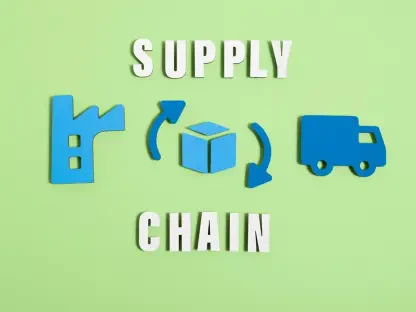The automotive logistics industry has been grappling with unprecedented challenges over the past few years. The Covid-19 pandemic, which began in 2020, has left a lasting impact on the sector, creating a state of continuous disruption. This article delves into the persistent issues faced by the industry, the evolving strategies to address them, and the role of technological innovations in enhancing forecasting and operational efficiency.
The Impact of the Covid-19 Pandemic
Disruption and Uncertainty
The Covid-19 pandemic severely disrupted the automotive logistics sector, leading to significant challenges in labor, capacity, and predictability. Companies like Nissan struggled to communicate expectations to suppliers due to the fragile nature of predictions during the pandemic. The industry faced a sudden halt in production, followed by a surge in demand, creating a volatile environment that was difficult to navigate.
One of the primary reasons for this instability was the drastic drop in consumer demand initially, causing manufacturers to shut down production lines. However, as economies began to reopen and consumer confidence rebounded, there was a sharp increase in vehicle demand that outpaced the supply chain’s ability to react swiftly. This sudden swing from low to high demand intensified the logistical challenges, exacerbating delays and inefficiencies in the supply chain.
Long-Lasting Effects
The effects of the pandemic have been long-lasting, with many companies still grappling with the aftermath. The recovery has been uneven, with some sectors experiencing chronic undercapacity, such as finished vehicle logistics (FVL) and rail in North America, while others, like container shipping, face overcapacity. This imbalance has further complicated the industry’s ability to forecast and plan effectively.
Compounding these issues, the pandemic caused labor shortages across the industry, with many skilled workers leaving or being furloughed. As a result, rebuilding workforce capacity has been slow, and many companies are still struggling to hire and train new employees. Additionally, the forced adoption of remote work operations and changing health protocols added layers of complexity to logistics management, making it even more challenging to ensure a consistent and reliable supply chain.
Current and Ongoing Challenges
The ‘Perma-Crisis’ State
The automotive logistics industry is now in a state of ‘perma-crisis,’ characterized by continuous external disruptions. These include semiconductor shortages, inflation, geopolitical tensions, and extreme weather conditions. This constant state of crisis has necessitated a shift towards more resilient and adaptable operational models.
Industries have had to quickly adapt to this ‘perma-crisis’ by implementing more agile supply chain processes capable of withstanding external shocks. This adaptation demands a significant overhaul of traditional logistics practices, which were primarily built on the assumption of steady, predictable demand and stable supply chains. Resilience is now paramount, requiring companies to build flexibility into every aspect of their operations, from supplier relationships to inventory management.
Capacity Issues
Capacity issues remain a significant challenge for the industry. Some logistics sectors are struggling with undercapacity, while others face overcapacity. This imbalance has made it difficult for companies to maintain predictable supply chains and has highlighted the need for more flexible and resilient logistics networks.
In the context of undercapacity, sectors like FVL and rail are unable to keep up with the demand for transportation, leading to delayed vehicle deliveries and increased costs for storing unsold inventory. On the other hand, overcapacity in container shipping results in reduced shipping rates and inefficiencies, as operators struggle to balance their fleet utilization. These opposing pressures on capacity exacerbate the logistical difficulties faced by automotive companies, necessitating innovative solutions to balance and optimize capacity across different transportation modes.
Data Exchange and Visibility
Importance of Data Exchange
Adequate visibility and data exchange within the supply chain are crucial for mitigating crises. However, these are often undermined by silo-thinking and the complexity of the logistics value chain. Companies like GM provide a two-year outlook by month for their plants to facilitate better planning, but not all suppliers are aware or capable of accessing this information.
Visibility within the supply chain allows companies to anticipate potential disruptions more accurately and take proactive measures to address them. However, without seamless data exchange and collaboration between all stakeholders, achieving this visibility is challenging. Siloed data systems restrict the flow of information, preventing companies from fully utilizing the insights necessary for precise forecasting and decision-making. This fragmentation highlights the pressing need for integrated data platforms that can facilitate real-time information sharing across the entire logistics network.
Modernizing Data Management
There is a need for modernized and standardized data management systems across the supply chain to improve visibility and predictive capabilities. Eliminating data silos and adopting a standardized approach to data management can enhance collaboration and lead to better decision-making.
Implementing cutting-edge data management systems, such as cloud-based platforms and blockchain technology, can significantly improve the accuracy and speed of information exchange. Standardization of data formats and communication protocols will further streamline processes and reduce misunderstandings or discrepancies between different stakeholders. By investing in these modern technologies, companies can transform their supply chains into well-coordinated and resilient networks capable of withstanding ongoing external disruptions.
Use of Technological Innovations
Artificial Intelligence and Predictive Analytics
Technologies like artificial intelligence (AI) and predictive analytics are seen as potential tools to enhance demand forecasting and optimize logistics. However, their adoption is still in the nascent stages. The use of AI comes with concerns around learning cycles for accuracy, fraud protection, and cybersecurity risks.
AI and predictive analytics can transform supply chain management by analyzing vast amounts of data, identifying patterns, and generating accurate forecasts. These tools can help companies anticipate demand fluctuations, optimize inventory levels, and identify potential disruptions before they occur. Despite their potential, the integration of these technologies is still in the early stages, and many companies are hesitant to fully embrace AI due to concerns about its reliability and the potential risks associated with cybersecurity and fraud.
Gradual Integration
The automotive logistics sector acknowledges the need for a measured approach to technology adoption. Companies must carefully assess their readiness and potential security risks before integrating these technologies. Gradual integration can help ensure that AI and predictive analytics align with existing capabilities and security requirements.
By taking a phased approach to technology adoption, companies can mitigate risks and ensure a smooth transition. Starting with smaller pilot projects and progressively scaling up allows organizations to test the effectiveness of AI and predictive analytics in their specific supply chain contexts. This gradual integration not only minimizes potential disruptions but also provides valuable insights that can guide the broader implementation of these technologies across the logistics network.
Financial and Operational Implications
Financial Volatility
The financial volatility in the logistics industry, with slim margins and rising interest rates, has stressed the importance of reliable forecasting. The need for sustainable investments, such as zero-emission fleets, further underscores the importance of precise and reliable forecasting to support strategic decision-making.
Logistics companies operate within tight financial constraints, where even minor forecasting errors can have significant consequences. The rising interest rates have increased the cost of capital, making it more challenging for companies to invest in necessary infrastructure and technology upgrades. Moreover, the shift toward sustainable operations, driven by regulatory requirements and customer demand, necessitates long-term financial planning and accurate volume forecasts to justify investment in green technologies like zero-emission fleets.
Balancing Cost Control and Strategic Investments
Logistics service providers (LSPs) need to balance cost control with strategic investments to ensure business continuity without jeopardizing financial stability. This balance is crucial for maintaining operational efficiency and adapting to ongoing external disruptions.
Achieving this balance requires a comprehensive understanding of both current and future logistical needs. LSPs must prioritize cost-efficient practices while identifying strategic investment opportunities that can enhance long-term resilience. Investment in areas such as advanced data analytics, AI, and sustainable technologies should align with the broader goal of creating a more adaptable logistics network. This approach ensures that companies can navigate the financial uncertainties inherent in the industry without compromising their ability to respond to ongoing disruptions.
Enhanced Collaboration and Data Utilization
Eliminating Data Silos
Improved collaboration between automotive companies and their supply chain partners is essential for better data exchange, leading to enhanced visibility and predictive capabilities. There is a consensus that data silos need to be eliminated, and a standardized approach to data management should be adopted.
Breaking down data silos involves creating integrated systems where information can flow freely between different departments and partners. This requires a cultural shift towards greater transparency and collaboration, supported by the adoption of interoperable technologies. By fostering a collaborative environment, companies can leverage diverse data sources to gain comprehensive insights, improving their ability to anticipate disruptions and adjust their operations accordingly.
Standardized Data Management
Adopting standardized data management systems can help improve collaboration and lead to better decision-making. This approach can enhance the industry’s ability to respond quickly and efficiently to external disruptions, ensuring stability and growth in an increasingly unpredictable environment.
Standardized data management involves establishing common protocols for data collection, storage, and sharing, ensuring consistency and accuracy across the supply chain. Implementing these standards enhances interoperability and reduces the likelihood of miscommunication or data discrepancies. With a unified data management system, companies can make more informed decisions, streamline their operations, and build a more resilient logistics network capable of weathering ongoing challenges.
Technological Integration
Cautious Optimism
There is cautious optimism about the benefits of AI and predictive analytics. The automotive logistics sector recognizes the potential of these technologies to enhance forecasting accuracy and operational efficiency. However, companies must carefully assess their readiness and potential security risks before integrating these tools.
The potential for AI and predictive analytics to transform logistics operations is immense, offering the ability to predict demand more accurately, optimize routes, and enhance overall supply chain efficiency. Despite this optimism, the implementation of such technologies requires careful planning and consideration of potential pitfalls. Security concerns, particularly around data privacy and cyber threats, must be addressed to build confidence in these innovations.
Strategic Application
The automotive logistics sector has been facing significant and unprecedented challenges in recent years, majorly impacted by the Covid-19 pandemic that erupted in 2020. This pandemic has caused long-term disruptions that continue to affect the industry, creating a cycle of ongoing difficulties and adjustments. This article explores these persistent challenges, the strategies that are being developed and implemented to combat them, and how technological advancements are playing a crucial role in improving forecasting and operational efficiency within the sector.
By 2021, the automotive logistics industry was already dealing with a range of issues, from supply chain disruptions to labor shortages. Factories shut down or operated at reduced capacities, and restrictions on movement further complicated logistics operations. This ripple effect not only slowed down production but also created bottlenecks, leading to delays and increased costs.
As the industry adapts, companies are rethinking their logistics strategies. They are increasingly investing in technology to gain better visibility into their supply chains, allowing for more accurate forecasting and more efficient operations. Technologies such as artificial intelligence and machine learning are being deployed to analyze data, predict disruptions, and optimize routes and inventory management.
In summary, the automotive logistics sector is in a period of transformation. The challenges brought about by the pandemic have accelerated the adoption of innovative solutions, aiming for greater resilience and efficiency in the face of ongoing uncertainties.









